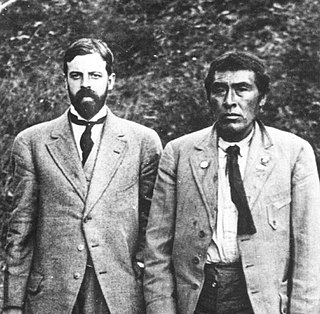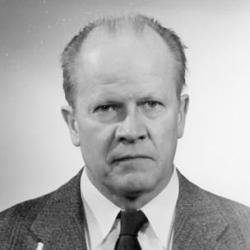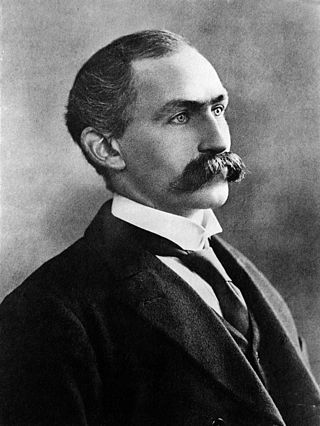Related Research Articles

The University of Pennsylvania Museum of Archaeology and Anthropology—commonly known as the Penn Museum—is an archaeology and anthropology museum at the University of Pennsylvania. It is located on Penn's campus in the University City neighborhood of Philadelphia, at the intersection of 33rd and South Streets. Housing over 1.3 million artifacts, the museum features one of the most comprehensive collections of middle and near-eastern art in the world.

Alfred Louis Kroeber was an American cultural anthropologist. He received his PhD under Franz Boas at Columbia University in 1901, the first doctorate in anthropology awarded by Columbia. He was also the first professor appointed to the Department of Anthropology at the University of California, Berkeley. He played an integral role in the early days of its Museum of Anthropology, where he served as director from 1909 through 1947. Kroeber provided detailed information about Ishi, the last surviving member of the Yahi people, whom he studied over a period of years. He was the father of the acclaimed novelist, poet, and writer of short stories Ursula K. Le Guin.

Prehistoric archaeology is a subfield of archaeology, which deals specifically with artefacts, civilisations and other materials from societies that existed before any form of writing system or historical record. Often the field focuses on ages such as the Stone Age, Bronze Age and Iron Age, although it also encompasses periods such as the Neolithic. The study of prehistoric archaeology reflects the cultural concerns of modern society by showing interpretations of time between economic growth and political stability. It is related to other disciplines such as geology, biology, anthropology, historiography and palaeontology, although there are noticeable differences between the subjects they all broadly study to understand; the past, either organic or inorganic or the lives of humans. Prehistoric archaeology is also sometimes termed as anthropological archaeology because of its indirect traces with complex patterns.

Material culture is the aspect of social reality grounded in the objects and architecture that surround people. It includes the usage, consumption, creation, and trade of objects as well as the behaviors, norms, and rituals that the objects create or take part in. Some scholars also include other intangible phenomena that include sound, smell and events, while some even consider language and media as part of it. The term is most commonly used in archaeological and anthropological studies, to define material or artifacts as they are understood in relation to specific cultural and historic contexts, communities, and belief systems. Material culture can be described as any object that humans use to survive, define social relationships, represent facets of identity, or benefit peoples' state of mind, social, or economic standing. Material culture is contrasting to symbolic culture, which includes nonmaterial symbols, beliefs, and social constructs.
Jonathan Mark Kenoyer is an American archaeologist and George F. Dales Jr. & Barbara A. Dales Professor of Anthropology at the University of Wisconsin–Madison. He earned his Bachelor of Arts, Master's, and Doctorate degrees at the University of California, Berkeley, finishing in 1983. Kenoyer is president of the Society of Bead Researchers.

Emile Louis Bruno Clement (1844–1928) was a prominent collector of ethnographic artefacts and natural history specimens from northwest Australia at the end of the nineteenth and early twentieth centuries.
Patrick Vinton Kirch is an American archaeologist and Professor Emeritus of Integrative Biology and the Class of 1954 Professor of Anthropology at the University of California, Berkeley. He is also the former Curator of Oceanic Archaeology in the Phoebe A. Hearst Museum of Anthropology, and director of that museum from 1999 to 2002. Currently, he is professor in the department of anthropology at the University of Hawai'i Manoa, and a member of the board of directors of the Bishop Museum.

The Museum of Archaeology and Anthropology, also known as MAA, at the University of Cambridge houses the university's collections of local antiquities, together with archaeological and ethnographic artefacts from around the world. The museum is located on the university's Downing Site, on the corner of Downing Street and Tennis Court Road. In 2013 it reopened following a major refurbishment of the exhibition galleries, with a new public entrance directly on to Downing Street.
Anthropology, or Anthropologie in some languages, refers primarily to a science and arts. An Anthropologist practices anthropology. Anthropological is "having to do with anthropology." This word set may refer to:

Roger Curtis Green was an American-born, New Zealand-based archaeologist, Professor Emeritus at The University of Auckland, and member of the National Academy of Sciences and Royal Society of New Zealand. He was awarded the Hector and Marsden Medals and was an Officer of the New Zealand Order of Merit for his contributions to the study of Pacific culture history.

Lauriston Sharp was a Goldwin Smith Professor of Anthropology and Asian Studies at Cornell University. He was the first person appointed in anthropology at the university, and he created its Southeast Asia Program, research centers in Asia and North and South America, a multidisciplinary faculty and strong language program. He was a founding member of the Society for Applied Anthropology and a founding trustee of the Asia Society.
The following outline is provided as an overview of and topical guide to anthropology:
Pacific studies is the study of the Pacific region (Oceania) across academic disciplines such as anthropology, archeology, art, economics, geography, history, linguistics, literature, music, politics, or sociology.

Henry Balfour FRS FRAI was a British archaeologist, and the first curator of the Pitt Rivers Museum.
Mark James Hudson is a British archaeologist interested in multicultural Japan. His initial areas of specialization were the Jōmon period and the Yayoi period. His later research has focused on areas of Japan outside state control, primarily islands and mountains. He excavated the Nagabaka site on Miyako Island.
The Anthropological Society of New South Wales was formed in 1928, by William Walford Thorpe, ethnologist of the Australian Museum, Clifton Cappie Towle and three others.
Anthropology is the study of various aspects of humans within past and present societies. This study is practiced in multiple countries, each of whom has their own history of how anthropology has developed in their respective countries.
Left Coast Press was an independent, scholarly publishing house specializing in social sciences and humanities. Based in Walnut Creek, California, and distributed globally, the company published approximately 500 books between 2005 and 2016 before the company was purchased by Routledge, who rebranded them as Routledge books. The company also published 13 scholarly journals before its journals division was sold in 2012 to Maney Publishing, now part of Taylor & Francis.
Stephanie Moser is an archaeology professor and head of the department at the University of Southampton, England. Her work explores the exhibition and reception of the human past. Moser's research examines visual images from antiquity through the lens of modern anthropology.